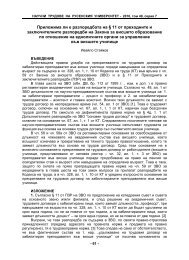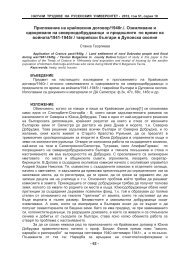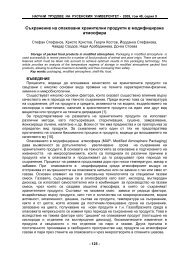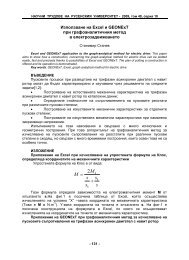3D Model of the Differential Planetary Gear and the Kinematic and ...
3D Model of the Differential Planetary Gear and the Kinematic and ...
3D Model of the Differential Planetary Gear and the Kinematic and ...
Create successful ePaper yourself
Turn your PDF publications into a flip-book with our unique Google optimized e-Paper software.
НАУЧНИ ТРУДОВЕ НА РУСЕНСКИЯ УНИВЕРСИТЕТ - 2012, том 51, серия 1.1<br />
<strong>3D</strong> <strong>Model</strong> <strong>of</strong> <strong>the</strong> <strong>Differential</strong> <strong>Planetary</strong> <strong>Gear</strong><br />
<strong>and</strong> <strong>the</strong> <strong>Kinematic</strong> <strong>and</strong> Force Analysis<br />
Juraj Jablonický, Ľubomír Hujo, Zdenko Tkáč, Ján Kosiba<br />
Abstract: The goal <strong>of</strong> <strong>the</strong> presented contribution was to design <strong>of</strong> <strong>the</strong> differential mechanical gear box<br />
with power shit. According to <strong>the</strong> designed force scheme, basic forces <strong>and</strong> kinematics relationships between<br />
input <strong>and</strong> output parameters were specified. Force <strong>and</strong> kinematic analyze is presented in tabular <strong>and</strong> graphic<br />
form. The o<strong>the</strong>r part <strong>of</strong> <strong>the</strong> contribution was to design planetary gear box which is placed in <strong>the</strong> primary<br />
branch <strong>of</strong> differential gear box <strong>and</strong> variable gear which is placed in secondary branch <strong>of</strong> differential gear box.<br />
Variable ratio allows shifting 16 speed gears.<br />
Key words: power shift, planetary gear, differential mechanical gear, kinematic analyze, force<br />
analyze<br />
INTRODUCTION<br />
The main purpose is to allow <strong>the</strong> gear change transmission between <strong>the</strong> engine <strong>and</strong><br />
<strong>the</strong> driving wheels so that <strong>the</strong> motor regardless <strong>of</strong> <strong>the</strong> speed to remain high speed at which<br />
it has <strong>the</strong> greatest power. In addition, <strong>the</strong> transmission line to meet additional<br />
requirements.<br />
Through reverse gear must allow reversing <strong>the</strong> vehicle when driving on a slope<br />
provides engine braking when <strong>the</strong> vehicle included such gear that would do <strong>the</strong> same<br />
slope are entering. While driving in a lower gear provides more flexible ride with less<br />
speed vehicle achieves greater acceleration, easier to overtake slower vehicles. All<br />
transmission gears are adjusted so that <strong>the</strong> drive shaft was disconnected from <strong>the</strong> driven<br />
shaft <strong>and</strong> set <strong>the</strong> neutral gear [1, 6, 7].<br />
As Vlk writes [5] <strong>the</strong> transmission is used to change <strong>the</strong> transmitted torque <strong>and</strong> its<br />
long-term disruption <strong>and</strong> also to change its meaning (reverse). This is achieved by <strong>the</strong><br />
transfer, which allows you to change gear. Speed transmissions are ei<strong>the</strong>r gear too<strong>the</strong>d<br />
spur gears or planetary gearbox with gear wheels [2, 3, 5]. Speed gears belong to a h<strong>and</strong><br />
with a change <strong>of</strong> gear <strong>of</strong>f <strong>the</strong> clutch, <strong>the</strong> impact <strong>of</strong> each interrupt transmission <strong>of</strong> <strong>the</strong> drive<br />
torque. This is a disadvantage when traveling especially to climb for trucks.<br />
Continuous transmission allows continuous change <strong>of</strong> torque automatically.<br />
Applications include automatic transmission with torque converter, which allows multi-plate<br />
clutch shift without interrupting torque transmission [4, 5].<br />
MATERIAL AND METHODS<br />
<strong>Kinematic</strong>s analyse <strong>of</strong> differential planetary gear with differential on output.The body<br />
<strong>of</strong> <strong>the</strong> differential gear box is elementary planetary gear that consists <strong>of</strong> sun wheel that is<br />
connected with output shaft, satellites 2, ring gear 3 <strong>and</strong> planet currier 4 that is connected<br />
with input shaft. <strong>Differential</strong> mechanism has planetary gear with two driven elements. The<br />
first one is sun wheel <strong>and</strong> second one is ring gear. The second driven member is by<br />
means <strong>of</strong> gear set z8, z7, variable gear ratio iv <strong>and</strong> gear set z6, z5 connected with output<br />
shaft. Form <strong>the</strong> point <strong>of</strong> view <strong>of</strong> kinematics is necessary to find relation between gear ratio<br />
i41* <strong>and</strong> secondary gear ratio i13* (Figure 1) according to:<br />
i 41 * = f ( i13<br />
*)<br />
(1)<br />
<strong>Kinematic</strong>s analyse <strong>of</strong> differential gear box was realised on <strong>the</strong> basis <strong>of</strong> relations for<br />
planetary gear with one degree <strong>of</strong> freedom. Revolutions <strong>of</strong> output shaft n1 are dependence<br />
on revolutions <strong>of</strong> input shaft n4 <strong>and</strong> ring gear n3:<br />
n 1 = f ( n4<br />
, n3<br />
) rpm<br />
(2)<br />
Output revolutions <strong>of</strong> elementary planetary gear n1 are:<br />
n4<br />
n3<br />
n1 = −<br />
rpm<br />
(3)<br />
i41<br />
i31<br />
- 177 -
НАУЧНИ ТРУДОВЕ НА РУСЕНСКИЯ УНИВЕРСИТЕТ - 2012, том 51, серия 1.1<br />
Figure 1. <strong>Kinematic</strong>s scheme <strong>of</strong> differential planetary gear<br />
Revolutions <strong>of</strong> ring gear n3 on <strong>the</strong> basis <strong>of</strong> kinematics scheme shown in Fig.1 are:<br />
n1<br />
n 3 =<br />
i13<br />
*<br />
rpm (4)<br />
Value <strong>of</strong> secondary gear ratio i13* is:<br />
n3<br />
n5<br />
n7<br />
i13 * = = ⋅ iv<br />
⋅<br />
n1<br />
n6<br />
n8<br />
From <strong>the</strong> kinematics scheme (Figure 1) is valid:<br />
n 1 = n4<br />
n = n<br />
(5)<br />
3<br />
7<br />
5<br />
i 5 = ,<br />
6<br />
n6<br />
n n6<br />
n7<br />
iv = , i 78 =<br />
n7<br />
n8<br />
By substitution to relation 5:<br />
i * = i . iv.<br />
i<br />
(6)<br />
13 56<br />
78<br />
Value <strong>of</strong> gear ratio i13* according to relation 6 is dependent on value <strong>of</strong> variable gear<br />
ratio iv (gear ratio i65 <strong>and</strong> i78 are constant).<br />
<strong>Differential</strong> gear ratio i41* is:<br />
n4<br />
i 41* = (7)<br />
n<br />
1<br />
By substitution <strong>of</strong> <strong>the</strong> revolutions n3 from relation 4 to relation 3 revolutions n1 are:<br />
n4<br />
n1<br />
n1 = −<br />
i41<br />
i31.<br />
i13<br />
*<br />
rpm (8)<br />
By dividing <strong>of</strong> relation 8 by revolutions n1 we can relation 8 to write as following:<br />
n4<br />
1<br />
1 = −<br />
n1.<br />
i41<br />
i31.i13<br />
*<br />
The final relation for differential planetary gear i41* than is:<br />
(9<br />
n4<br />
i31.<br />
i13<br />
* + 1<br />
i41 * = = ⋅i<br />
41<br />
n1<br />
i31.<br />
i13<br />
*<br />
(10)<br />
Value <strong>of</strong> differential gear i13* according to <strong>the</strong> relation 10 is specified by kinematics<br />
parameters <strong>of</strong> <strong>the</strong> elementary planetary gear (gear ratios i31 <strong>and</strong> i41) <strong>and</strong> secondary gear<br />
ratio i13*. Secondary gear ratio is depending on <strong>the</strong> value <strong>of</strong> variable gear ratio iv. Output<br />
differential gear ratio i41* is function <strong>of</strong> variable gear ratio iv according to <strong>the</strong> following<br />
formula:<br />
i * = f ( i )<br />
(11)<br />
41 v<br />
- 178 -
НАУЧНИ ТРУДОВЕ НА РУСЕНСКИЯ УНИВЕРСИТЕТ - 2012, том 51, серия 1.1<br />
Force analyse <strong>of</strong> differential planetary gear with differential on output.<br />
Force analysis <strong>of</strong> <strong>the</strong> planetary differential mechanism which is shown in Figure. 2<br />
will be made on <strong>the</strong> basis <strong>of</strong> a simple planetary conditions power transfer being preferred<br />
using kinematic relationships. Circuit forces <strong>the</strong> individual members <strong>of</strong> simple planetary<br />
transfer are shown in Fgure 2 from which can be written values <strong>of</strong> <strong>the</strong> moments.<br />
Figure 2. Power ratio differential planetary gear<br />
As can be seen from <strong>the</strong> power differential planetary gearing ratios shown in Figure<br />
2, <strong>the</strong> torque input Mv is <strong>the</strong> same moment M4 operating <strong>the</strong> ring gear as applying:<br />
M v = M 4<br />
Nm (12)<br />
Output torque will be <strong>the</strong> sum <strong>of</strong> MVY moments - M1 <strong>and</strong> M1 can be expressed as<br />
follows:<br />
M vy = M 1 + ΔM<br />
1<br />
Moment M3 is given by:<br />
Nm (13)<br />
M 3 = F23.R3<br />
moreover:<br />
Nm (14)<br />
M 1 = M 4.i41<br />
Nm (15)<br />
M 1 = M 3.i31<br />
Nm (16)<br />
The moment acting on <strong>the</strong> M3 ring gear can be expressed as follows:<br />
M 3 = F23.R3<br />
Nm (17)<br />
Where <strong>the</strong> following applies:<br />
M 3 = M1.i13<br />
Nm (18)<br />
M 3 = M 4.i43<br />
Nm (19)<br />
The power relationships described in Figure 4 is clear that <strong>the</strong> torque M3 operating<br />
<strong>the</strong> crown wheel 3 is transferred gears z7, z8 through transfer iv <strong>and</strong> finally gear wheels z5,<br />
z6 (transfer i56) to <strong>the</strong> drive shaft planetary transmission. Then increase <strong>the</strong> time<br />
<strong>the</strong> drive shaft planetary gear can be expressed by:<br />
M1 on<br />
Δ M1 = M 3.<br />
i56.<br />
iv.<br />
i78<br />
Nm (20)<br />
After <strong>the</strong> introduction <strong>of</strong> secondary transmission ratio <strong>of</strong> i41 *, which is given by:<br />
i41 * = i56.<br />
iv.<br />
i78<br />
We get:<br />
(21)<br />
Δ M 1 = M3.<br />
i41<br />
*<br />
Nm (22)<br />
Then MVY output torque on <strong>the</strong> driven shaft planetary gear differential is <strong>the</strong> sum <strong>of</strong><br />
<strong>the</strong> torque moment M1 a M1 growth, which can be expressed as follows:<br />
M vy = M 1 + ΔM<br />
1<br />
Nm (23)<br />
In fur<strong>the</strong>r addressing power relationships differential planetary transmission is based<br />
on <strong>the</strong> effective moment <strong>of</strong> M1, which is given by:<br />
M1 = M v.i41<br />
Nm (24)<br />
- 179 -
НАУЧНИ ТРУДОВЕ НА РУСЕНСКИЯ УНИВЕРСИТЕТ - 2012, том 51, серия 1.1<br />
Moment at <strong>the</strong> crown wheel M3 can be expressed by <strong>the</strong> following relationships:<br />
M 3 = M1.i13<br />
or:<br />
Nm (25)<br />
M 3 = M v.i43<br />
Nm (26)<br />
Substituting for <strong>the</strong> value <strong>of</strong> <strong>the</strong> torque M1 we get:<br />
Δ M1 = M v.<br />
i43.<br />
i41<br />
*<br />
Nm (27)<br />
Interdependence between <strong>the</strong> output <strong>and</strong> <strong>the</strong> input torque MVY moment Mv is given<br />
by <strong>the</strong> following relationship:<br />
M vy = M v.<br />
i41<br />
+ M v.<br />
i43.<br />
i56.<br />
iv.<br />
i79<br />
Nm (28)<br />
From <strong>the</strong> relation (28) shows that in <strong>the</strong> case <strong>of</strong> differential planetary gear is a<br />
function <strong>of</strong> output torque MVY variable gear ratio also provided that <strong>the</strong> o<strong>the</strong>r gear ratios<br />
are constant.<br />
RESULTS<br />
On <strong>the</strong> basis <strong>of</strong> kinematics scheme was created computer model <strong>of</strong> differential<br />
planetary gear box. Transmission mechanism is differential because secondary branch is<br />
parallel- connected with primary branch. Secondary branch makes it possible to shift 16<br />
gear speed ratio according to:<br />
n<br />
Y = X<br />
(29)<br />
Design <strong>and</strong> arrangement <strong>of</strong> basic planetary gear in primary <strong>and</strong> secondary branch<br />
In primary branch <strong>of</strong> differential mechanical branch is placed elementary gear (Figure<br />
4). Driving element is planet currier, primary driven element is sun wheel <strong>and</strong> secondary<br />
driven element is ring gear.In secondary branch are in-line connected four planet gears<br />
(Figure 5). These gears created variable gear ratio iv. Driving element each <strong>of</strong> gears in<br />
secondary branch is ring gear <strong>and</strong> driven element is planet currier. Dependence <strong>of</strong> gear<br />
ratios shown graphically in Figure 6. Depending on <strong>the</strong> value <strong>of</strong> output torque to input<br />
shown graphical solution in Figure 7.<br />
Figure 4. <strong>Planetary</strong> gear in primary branch<br />
1- sun wheel, 2- satellite, 3- ring gear, 4-planet<br />
carrier, 5- gear wheel z8<br />
- 180 -<br />
Figure 5. <strong>Planetary</strong> gears in secondary branch<br />
Figure 5. Dependency <strong>of</strong> primary differential gear ratio i41*<br />
in value <strong>of</strong> secondary differential gear ratio i13*
НАУЧНИ ТРУДОВЕ НА РУСЕНСКИЯ УНИВЕРСИТЕТ - 2012, том 51, серия 1.1<br />
M vy Nm<br />
600,00<br />
500,00<br />
400,00<br />
300,00<br />
200,00<br />
100,00<br />
0,00<br />
50,00 150,00 250,00 350,00 450,00 550,00<br />
Mv Nm<br />
- 181 -<br />
i41=0,33 i41=0,25<br />
i41=0,20 i41=0,17<br />
i41=0,14 i41=0,13<br />
Figure 6. The dependence <strong>of</strong> <strong>the</strong> output torque value on MVY<br />
input torque Mv value <strong>of</strong> gear ratio i31*= 1.46<br />
CONCLUSIONS<br />
This paper deals with power <strong>and</strong> kinematic analysis <strong>of</strong> planetary gear differential.<br />
Analytical solutions based on <strong>the</strong> fundamental strength <strong>and</strong> kinematic relations valid for<br />
simple planetary gear. Derived force <strong>and</strong> kinematic relations express <strong>the</strong> basic functional<br />
dependence between <strong>the</strong> value <strong>of</strong> <strong>the</strong> input torque <strong>and</strong> <strong>the</strong> output torque <strong>and</strong> also<br />
dependencies between <strong>the</strong> main <strong>and</strong> secondary gear ratio. Graphical solutions to power<br />
<strong>and</strong> kinematic conditions are shown in Figures 5 <strong>and</strong> 6.The analytical solution <strong>of</strong> <strong>the</strong><br />
differential planetary gear was prepared computer model <strong>of</strong> <strong>the</strong> transmission system <strong>and</strong><br />
<strong>the</strong>n <strong>the</strong> prototype gear serves to validate <strong>the</strong> calculated data.<br />
ACKNOWLEDGEMENT<br />
Supported by <strong>the</strong> Ministry <strong>of</strong> Education <strong>of</strong> <strong>the</strong> Slovak Republic, Project VEGA<br />
1/0857/12 “Reduction <strong>of</strong> unfavorable impacts <strong>of</strong> agricultural <strong>and</strong> transport machinery on<br />
environment”.<br />
LITERATURE<br />
[1] JABLONICKÝ, J. Diferenciálne prevody a ich aplikácia : dizertačná práca. [S.l. :<br />
s.n.], 2005. 190 s. Doktor<strong>and</strong>ská dizertačná práca (PhD.) SPU v Nitre, 2005.<br />
[2] JABLONICKÝ, J., ŽIKLA, A. Návrh a kinetická analýza diferenciálnej planétovej<br />
prevodovky. In 6. medzinárodná vedecká konferencia mladých 2004. Nitra :SPU, 2004.<br />
[3] JABLONICKÝ, J., ABRAHÁM, R., ŠVEC, J. Analýza silového zaťaženia<br />
prevodového systému. 2006 In Traktori i pogonske mašine. ISSN 0354-9496.<br />
[4] JABLONICKÝ, J., ABRAHÁM, R., ŠVEC, J. Analýza silového zaťaženia<br />
diferencionálneho planétového prevodu. In Acta technologica agriculturae. ISSN 1335-<br />
2555, 2006, roč. 9, č. 4, s. 88-91<br />
[5] VLK, F. Zkoušení a diagnostika motorových vozidel. ISBN 80-234-6573-0,<br />
Nakladatelství. VLK, Brno 2000.<br />
[6] ŽIKLA, A., ABRAHÁM, R. JABLONICKÝ, J. Silová analýza diferenciálneho<br />
planétového prevodu. In III. Mezinárodní vědecká konference mladých 2001. Praha :<br />
Česká zemědělská univerzita, 2001. ISBN 80-213-0789-7.<br />
[7] ŽIKLA, A., DRABANT, Š., TKÁČ, Z., JABLONICKÝ, J. <strong>Differential</strong> transmission<br />
gear box with power shift. In Automotive industry - carrier <strong>of</strong> technological progress.<br />
Kragujevac : Faculty <strong>of</strong> mechanical engineering , 2006. ISBN 86-80581-95-X.

















